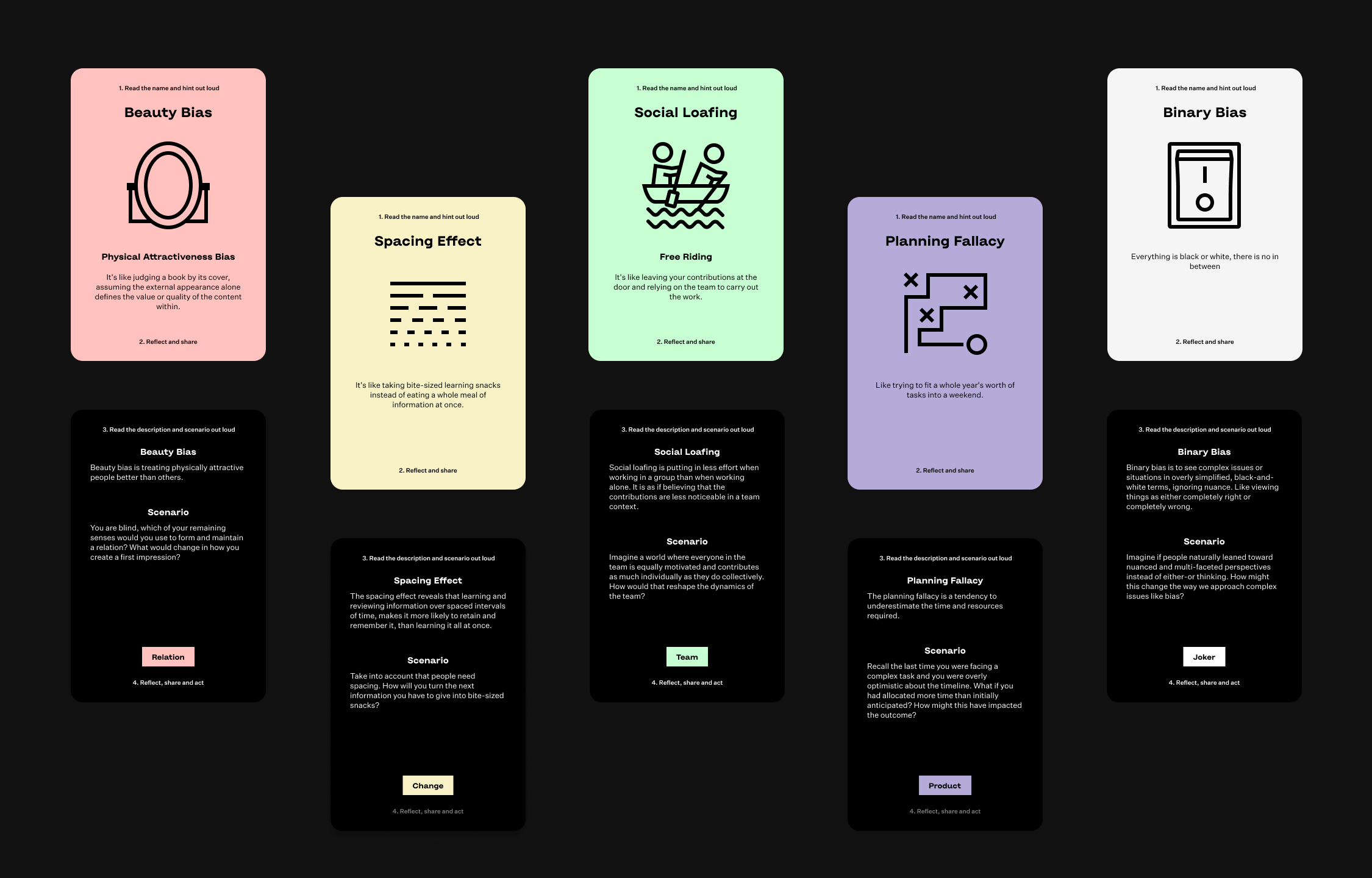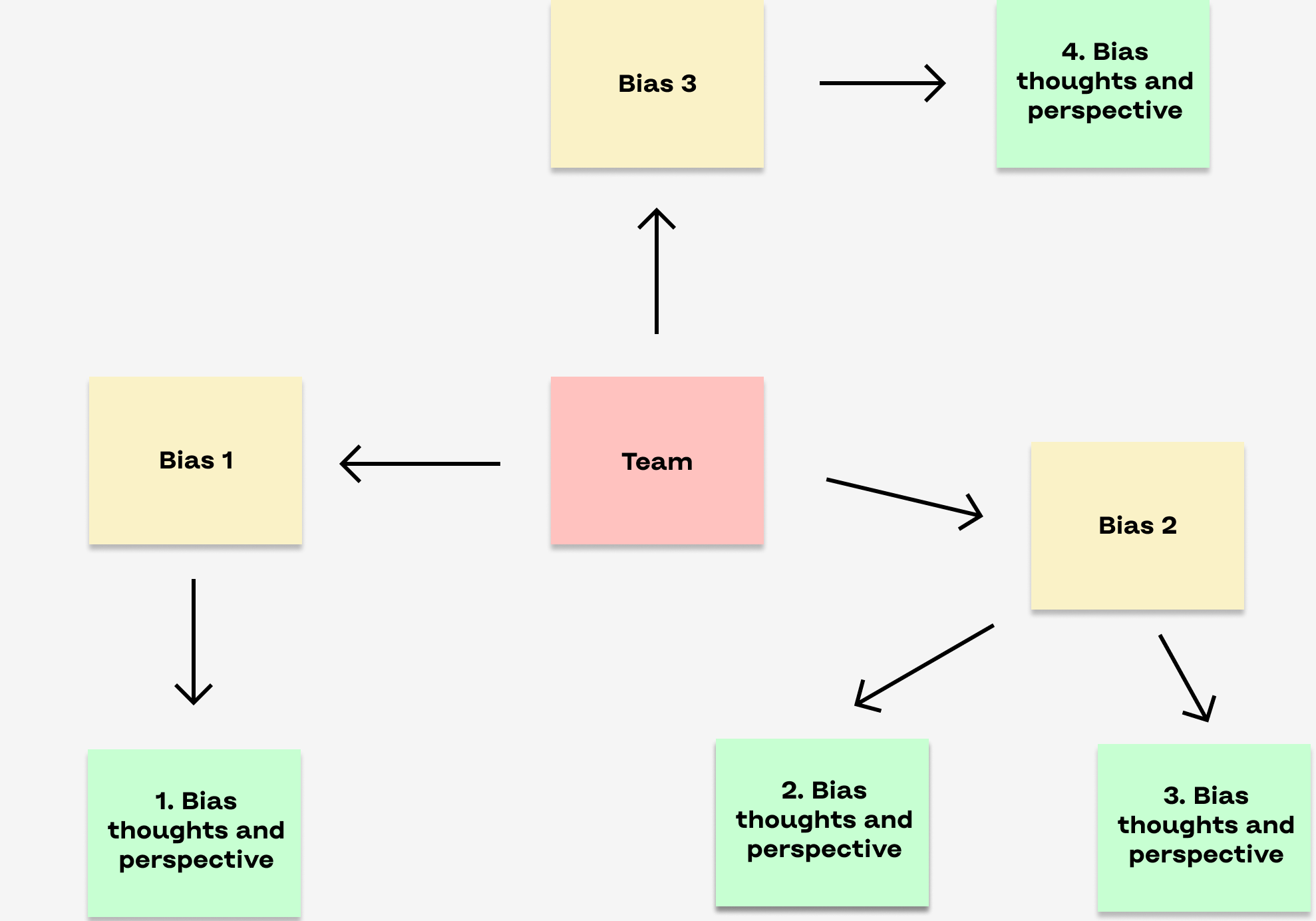How to Use Your
Bias Cards


The bias cards are a conversation tool that can help you understand, identify and shortcut biases so you can act on them. The cards can be used in many ways and in different contexts. One approach is already included in the box. We have created a few other approaches for different scenarios. Use them as written, or even better, tweak them to fit your needs.
This retrospective is created with a team in mind, looking back at the previous Sprint or iteration (or any given period), ready to inspect and adapt with bias as the viewport. It can be tweaked to be used for longer period time or a different group.
On a table, lay out the biases you have selected. Ask the participants individually to read all the biases with this question in mind and ask them to note their thoughts on post-its:
Place the team in the middle of a whiteboard. Could be a team name or a picture. Let all the participants place the biases and their notes with thought and perspectives around the team. Connect team, biases, and thoughts & perspectives. You’ll end up with something like this:

Place and connect everything before comments or questions.
Finally let the participants look at the overview with biases, thoughts, and perspectives. Each person shares their biggest aha experience.
Do you need to create a new product, or do changes to and existing product, could small or big changes. Or maybe retire a product? Biases will influence the work; this exercise will help you.
Want to do introspection? Then this short exercise is just the right one for you.
To talk about and work with bias, will most likely (without any doubt) be influenced by bias. Jokers about bias are 4 possibilities.
Embedded in those 4 jokers is important knowledge about bias, both highlighting what is hard about bias, but it can also help you when you work with bias. The importance to create a balance; not too much – not too little. The importance of creating focus and pinpointing where it makes a difference, instead of being all over the place.
This is one exercise on how to use the Jokers:
Let’s just start with the fact that biases aren’t inherently good or bad. They exist and they help you act without thinking and that is mostly a good thing. A bias can be seen as a shortcut in our mind and the way of thinking, that makes us react more quickly – a shortcut in our brain to make fast decisions. Some biases are also known as fallacies because the opinion that pops up in your head is false or doesn’t reflect the full picture. Try to think about your first interaction with your colleague, maybe the person nearest to you right now. What was your firsthand impression of that person, and what triggered you? Was it the hair, the cloth, or perhaps the person’s accent that caught your eye or ear? And what did it – without you even knowing the person – tell you about this person? No matter what you felt when you met this person, your firsthand impression was affected by your biases.
You will always be affected by your biases, and they follow you in your job and everywhere else. So, there is certainly something to work with, and that is why we have created Bias Cards – The Bias Shortcutter.
We have picked 53 biases out of the +200 biases that we can experience within ourselves or feel judged by in our interaction with others and grouped them in five categories:
And then we’ve wrapped them in a deck of cards.
A well-known example of a bias shortcut is removing names, pictures and age for job resumes and applications in a recruiting situation. What biases does that shortcut? Think about it before you read one.
This could be some of the biases that we can shortcut:





It is mostly negative impacts that are limited or mitigated in this case. It is important to remember that biases are also positive. In those cases, the bias shortcut is about how we can enforce or maximize the effect of what the biases provide.
Even though a bias shortcut itself might be simple and easy. It touches our own beliefs and values – some we might not even be aware of or proud of. Therefore, conversation about and identification of bias and their possible shortcut should not be taken lightly. Some key points to keep in mind when venturing into the world of bias:
· No jokes at the expense of others
· Practices deep listening
· Tell your story/perspective
· Have an open mind
Also, consider what works in one context or company might not work in another context or company. So don’t copy shortcuts blindly. Even though the end result might be similar, the conversation getting there is crucial to understanding the impact of bias and its meaning in your world.
Bias are the rulers of how we act per instinct. And negativity bias and overconfidence bias are some of the more prevalent biases of them all. You might think talking about bias is stupid and/or you might think that you’ve got this bias awareness all under control.
But here is the thing. This is exactly why it makes it even more relevant to address working with bias because not addressing bias can create a toxic working environment as we are all acting under the influence of our biases.
You might already work with bias shortcut like hiding the name and/or picture of the applicant to a job opening, but how about the bias you experience in your day-to-day job? With the card deck we would like to create more awareness of bias in the workplace.
Things aren’t as black and white as we often imagine them. It is in the colourful range between black and white that we find a more common ground of understanding towards each other. It is in the in-between between right and wrong we see things more clearly.
We hope that the cards will create a common language for you to talk about the in-between and layers of color that can help us be more open towards seeing things from another and more fruitful perspective.
Bias is not just a management issue it is an issue we are all responsible for addressing.
Don’t just use the tool once. You don’t have to address all biases at once. Do it in smaller batches over time. And revisit when needed. Don’t just talk – put action behind the words.
Create those bias shortcuts that could make a difference in your workplace.